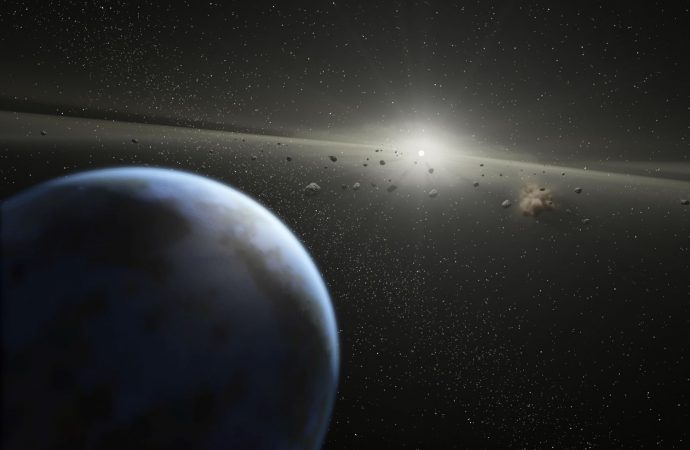Spending $50 million a year is a pittance in terms of managing this existential risk.
When the asteroid named 2014 J025 passed by the Earth in April, it came within 1.1 million miles of the planet — a close shave by cosmic standards and also the nearest in more than a decade. And J025 was big. At nearly a mile across, it could have killed tens of millions if it had hit a heavily populated area.
While its path was a matter of astronomy, J025’s discovery was largely a matter of luck. NASA is currently required by Congress to focus on locating near-Earth objects (NEOs) that are much smaller than J025, starting with ones bigger than a football field. But the agency has located less than a third of the more than 10,000 that are estimated to be out there, and there’s little chance of finding them all by its 2020 deadline.
Those figures are a reminder of the incomprensible mission of the Near-Earth Object Program. Yet its budget is a mere $50 million per year, having just survived — for now — an attempt by the Trump administration to cancel plans for a manned mission that would explore redirecting asteroids headed for Earth. To understand why that’s a pittance, you need to understand a very, very big idea: existential risk.
An existential risk is an event that could end the human race. These are the really, really big ones, either natural, like an unstoppable disease, or, increasingly, man-made, like the possibility that evolving artificial intelligence might one day decide to exterminate humanity. There is no coming back from existential risks; the loss is essentially infinite.
We know that asteroids are an existential risk because they have the track record. Sixty-six million years ago, a six-mile-wide asteroid slammed into what is now the Yucatan Peninsula — and ended the dinosaurs. With thousands of large NEOs out there, one will end up on a collision course with Earth sooner or later.
Timing, especially on this particular issue, is everything. If scientists knew that a large asteroid was almost certainly going to hit the Earth over the next decade, or even over the next century, money would be no object. It almost certainly won’t, though. In 2001, a U.K. task force estimated that an asteroid large enough to kill at least 1.5 billion people has just a one-in-250,000 chance of hitting the Earth in a given year. Which means we’ll be ok this year, and very likely for thousands of years into the future.
So why worry about asteroids at all? “The odds are small,” President Obama’s science adviser John Holdren told Congress in 2013, after a small asteroid broke up over the Russian city of Chelyabinsk. “But the potential consequences of such an event are so large, it makes sense to take the risk seriously.”
To begin to get a sense of how much we should be spending to avert an asteroid strike, we need to try to put a price on the priceless: the value of the human race. In his book “Catastrophe: Risk and Response”, the polymath jurist and economist Richard Posner tried to do just that, valuing a human life at $2 million. (The U.S. government, in judging the impact of regulations, has estimated a single American life at upwards of $9.1 million.) By those figures, an asteroid strike that killed 1.5 billion people would cost $3 quadrillion, or 3 million billion, which, with a one-in-250,000 yearly probability, works out to an annualized cost of asteroid strikes of $12 billion.
That’s anything but a precise figure. Because asteroid strikes are so rare, our estimates about the probability of a collision are necessarily imperfect. Then again, it could well turn out that the collisions are more likely than we think now, not less, which would make that annual cost even higher. But Posner’s calculations still make a strong argument that while we may not know exactly how much we should reasonably budget on asteroid defense, spending $50 million a year to protect ourselves from an event that could cost $12 billion annually is much too low.
Posner’s book brought much needed attention to the issue, in part because it was a judge writing about the risks of an asteroid strike, not a scientist. But there is still much more to prepare ourselves, without breaking the budget. At the cost of $500 to $750 million, NASA could put an infrared-sensing telescope in a Venus-like orbit, which would help identify asteroids that can’t currently be spotted from the ground because they are obscured by the sun’s glare. A National Academy of Sciences report pegged the cost of an optimal asteroid search program at about $100 million a year, which would have the added benefit of providing more reliable estimates about how often an asteroid might hit the Earth, which in turn would help us refine the calculation of how much we should be spending on defense. And with work, we’ll learn to defend ourselves.
The spending bill reached by Congress on April 30 ignored the White House’s request to cancel the Obama Administration’s plan to send a robotic craft to a near-Earth asteroid, followed later by astronauts, which would enable the agency to test out strategies to deflect an incoming object. The deal even increases funding for NASA by more than a half billion dollars and allows some of that money to be used on the planned asteroid mission. It’s a good step, even if the money doesn’t yet come close to matching the risk we face. A large asteroid hitting the Earth would be a natural disaster like no other — but as with any other natural disaster, the least we can do is buy a decent insurance policy.
Source: Bloomberg

































Leave a Comment
You must be logged in to post a comment.